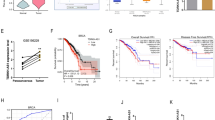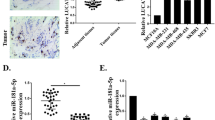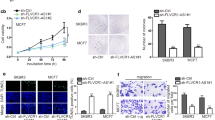Abstract
Introduction
As ceRNA network of long non-coding RNA (lncRNA)–microRNA (miR)–messenger RNAs (mRNA) can be predicted on the basis of bioinformatics tools, we are now one step closer to deeper understanding carcinogenic mechanisms. In this study, we clarified the mechanistic understanding of JHDM1D-AS1-miR-940-ARTN ceRNA network in the development of breast cancer (BC).
Materials and Methods
The lncRNA–miRNA–mRNA interaction of interest was predicted by in silico analysis and identified by conducting RNA immunoprecipitation, RNA pull-down and luciferase assays. The expression patterns of JHDM1D-AS1, miR-940 and ARTN in BC cells were altered by lentivirus infection and plasmid transfection for functional assays on the biological properties of BC cells. Finally, the tumorigenic and metastatic abilities of BC cells were assessed in vivo.
Results
JHDM1D-AS1 was highly expressed, while miR-940 was poorly expressed in BC tissues and cells. JHDM1D-AS1 could competitively bind to miR-940, whereby promoting the malignant behaviors of BC cells. Furthermore, ARTN was identified as a target gene of miR-940. Through targeting ARTN, miR-940 exerted a tumor-suppressive role. In vivo experiments further confirmed that JHDM1D-AS1 enhanced the tumorigenesis and metastasis through up-regulation of ARTN.
Conclusions
Taken together, our study demonstrated the involvement of ceRNA network JHDM1D-AS1-miR-940-ARTN in the progression of BC, which highlighted promising therapeutic targets for BC treatment.







Similar content being viewed by others
Availability of data and materials
The datasets generated/analyzed during the current study are available.
References
Harbeck N, Penault-Llorca F, Cortes J, Gnant M, Houssami N, Poortmans P, et al. Breast cancer. Nat Rev Dis Primers. 2019;5:66.
Britt KL, Cuzick J, Phillips KA. Key steps for effective breast cancer prevention. Nat Rev Cancer. 2020;20:417–36.
Fan L, Strasser-Weippl K, Li JJ, St Louis J, Finkelstein DM, Yu KD, et al. Breast cancer in China. Lancet Oncol. 2014;15:e279–89.
Peng WX, Koirala P, Mo YY. LncRNA-mediated regulation of cell signaling in cancer. Oncogene. 2017;36:5661–7.
Tan YT, Lin JF, Li T, Li JJ, Xu RH, Ju HQ. LncRNA-mediated posttranslational modifications and reprogramming of energy metabolism in cancer. Cancer Commun (Lond). 2021;41:109–20.
Hui L, Wang J, Zhang J, Long J. lncRNA TMEM51-AS1 and RUSC1-AS1 function as ceRNAs for induction of laryngeal squamous cell carcinoma and prediction of prognosis. PeerJ. 2019;7: e7456.
Wu M, Liu Y, Pu YS, Ma Y, Wang JH, Liu EQ. JHDM1D-AS1 aggravates the development of gastric cancer through miR-450a-2-3p-PRAF2 axis. Life Sci. 2021;265: 118805.
Hydbring P, Wang Y, Fassl A, Li X, Matia V, Otto T, et al. Cell-cycle-targeting MicroRNAs as therapeutic tools against refractory cancers. Cancer Cell. 2017;31(576–90): e8.
Serpico D, Molino L, Di Cosimo S. microRNAs in breast cancer development and treatment. Cancer Treat Rev. 2014;40:595–604.
Bhajun R, Guyon L, Pitaval A, Sulpice E, Combe S, Obeid P, et al. A statistically inferred microRNA network identifies breast cancer target miR-940 as an actin cytoskeleton regulator. Sci Rep. 2015;5:8336.
Hou L, Chen M, Yang H, Xing T, Li J, Li G, et al. MiR-940 inhibited cell growth and migration in triple-negative breast cancer. Med Sci Monit. 2016;22:3666–72.
Liu W, Xu Y, Guan H, Meng H. Clinical potential of miR-940 as a diagnostic and prognostic biomarker in breast cancer patients. Cancer Biomark. 2018;22:487–93.
Kang J, Perry JK, Pandey V, Fielder GC, Mei B, Qian PX, et al. Artemin is oncogenic for human mammary carcinoma cells. Oncogene. 2009;28:2034–45.
Zhu S, Li Y, Bennett S, Chen J, Weng IZ, Huang L, et al. The role of glial cell line-derived neurotrophic factor family member artemin in neurological disorders and cancers. Cell Prolif. 2020;53: e12860.
Banerjee A, Wu ZS, Qian P, Kang J, Pandey V, Liu DX, et al. ARTEMIN synergizes with TWIST1 to promote metastasis and poor survival outcome in patients with ER negative mammary carcinoma. Breast Cancer Res. 2011;13:R112.
Fang T, Lv H, Lv G, Li T, Wang C, Han Q, et al. Tumor-derived exosomal miR-1247-3p induces cancer-associated fibroblast activation to foster lung metastasis of liver cancer. Nat Commun. 2018;9:191.
Zhu J, Liu B, Wang Z, Wang D, Ni H, Zhang L, et al. Exosomes from nicotine-stimulated macrophages accelerate atherosclerosis through miR-21-3p/PTEN-mediated VSMC migration and proliferation. Theranostics. 2019;9:6901–19.
Han B, Jiang W, Cui P, Zheng K, Dang C, Wang J, et al. Microglial PGC-1alpha protects against ischemic brain injury by suppressing neuroinflammation. Genome Med. 2021;13:47.
Livak KJ, Schmittgen TD. Analysis of relative gene expression data using real-time quantitative PCR and the 2(-Delta Delta C(T)) Method. Methods. 2001;25:402–8.
Song J, Zhang W, Wang J, Yang H, Zhou Q, Wang H, et al. Inhibition of FOXO3a/BIM signaling pathway contributes to the protective effect of salvianolic acid A against cerebral ischemia/reperfusion injury. Acta Pharm Sin B. 2019;9:505–15.
Liu CY, Zhang YH, Li RB, Zhou LY, An T, Zhang RC, et al. LncRNA CAIF inhibits autophagy and attenuates myocardial infarction by blocking p53-mediated myocardin transcription. Nat Commun. 2018;9:29.
Qin X, Guo H, Wang X, Zhu X, Yan M, Wang X, et al. Exosomal miR-196a derived from cancer-associated fibroblasts confers cisplatin resistance in head and neck cancer through targeting CDKN1B and ING5. Genome Biol. 2019;20:12.
Chen J, Yu Y, Li H, Hu Q, Chen X, He Y, et al. Long non-coding RNA PVT1 promotes tumor progression by regulating the miR-143/HK2 axis in gallbladder cancer. Mol Cancer. 2019;18:33.
Chen J, Liu G, Wu Y, Ma J, Wu H, Xie Z, et al. CircMYO10 promotes osteosarcoma progression by regulating miR-370-3p/RUVBL1 axis to enhance the transcriptional activity of beta-catenin/LEF1 complex via effects on chromatin remodeling. Mol Cancer. 2019;18:150.
Liu Z, Sun J, Li C, Xu L, Liu J. MKL1 regulates hepatocellular carcinoma cell proliferation, migration and apoptosis via the COMPASS complex and NF-kappaB signaling. BMC Cancer. 2021;21:1184.
Akhtar S, Mahjabeen I, Akram Z, Kayani MA. CYP1A1 and GSTP1 gene variations in breast cancer: a systematic review and case-control study. Fam Cancer. 2016;15:201–14.
Miao LF, Ye XH, He XF. Individual and combined effects of GSTM1, GSTT1, and GSTP1 polymorphisms on breast cancer risk: A meta-analysis and re-analysis of systematic meta-analyses. PLoS ONE. 2020;15: e0216147.
Tosello G, Torloni MR, Mota BS, Neeman T, Riera R. Breast surgery for metastatic breast cancer. Cochrane Database Syst Rev. 2018;3:CD011276.
Yao G, Chen K, Qin Y, Niu Y, Zhang X, Xu S, et al. Long non-coding RNA JHDM1D-AS1 interacts with DHX15 protein to enhance non-small-cell lung cancer growth and metastasis. Mol Ther Nucleic Acids. 2019;18:831–40.
Kondo A, Nonaka A, Shimamura T, Yamamoto S, Yoshida T, Kodama T, et al. Long noncoding RNA JHDM1D-AS1 promotes tumor growth by regulating angiogenesis in response to nutrient starvation. Mol Cell Biol. 2017;37:e00125.
Xiao X, Zhang Y, Lin Q, Zhong K. The better effects of microbubble ultrasound transfection of miR-940 on cell proliferation inhibition and apoptosis promotion in human cervical cancer cells. Onco Targets Ther. 2019;12:6813–24.
Jiang K, Zhao T, Shen M, Zhang F, Duan S, Lei Z, et al. MiR-940 inhibits TGF-beta-induced epithelial-mesenchymal transition and cell invasion by targeting Snail in non-small cell lung cancer. J Cancer. 2019;10:2735–44.
Hezam K, Jiang J, Sun F, Zhang X, Zhang J. Artemin promotes oncogenicity, metastasis and drug resistance in cancer cells. Rev Neurosci. 2018;29:93–8.
Kang J, Qian PX, Pandey V, Perry JK, Miller LD, Liu ET, et al. Artemin is estrogen regulated and mediates antiestrogen resistance in mammary carcinoma. Oncogene. 2010;29:3228–40.
Ding K, Banerjee A, Tan S, Zhao J, Zhuang Q, Li R, et al. Artemin, a member of the glial cell line-derived neurotrophic factor family of ligands, is HER2-regulated and mediates acquired trastuzumab resistance by promoting cancer stem cell-like behavior in mammary carcinoma cells. J Biol Chem. 2014;289:16057–71.
Gao CB, Wang D, Wang Y, Liu YH. Artemin promotes proliferation and metastasis in human laryngeal squamous cell carcinoma. Int J Clin Exp Pathol. 2017;10:10413–8.
Funding
This study was funded by Key R&D and promotion projects in Henan Province in 2020 (202102310102).
Author information
Authors and Affiliations
Contributions
Yonggang Zuo and Mingde Ma contributed to the conception and design of the study; Yuqing Wen contributed to the acquisition of data; Liang Chang contributed to the analysis and interpretation of data; Yonggang Zuo and Changping Qu contributed to drafting the article; Mingde Ma and Yuqing Wen contributed to revising the article critically for important intellectual content; All of the authors approved the final version to be submitted.
Corresponding author
Ethics declarations
Conflict of interest
The authors declare that they have no competing interests.
Ethics statement
All individuals involved in this study signed informed consent. The study was approved by Ethics Committee of Huaihe Hospital, Henan University and in line with the ethical standards of the Declaration of Helsinki. The animal experiment was approved by the Animal Ethics Committee of Huaihe Hospital, Henan University.
Informed consent
All participants provided informed consent prior to their participation.
Additional information
Publisher's Note
Springer Nature remains neutral with regard to jurisdictional claims in published maps and institutional affiliations.
Supplementary Information
Below is the link to the electronic supplementary material.
Rights and permissions
Springer Nature or its licensor (e.g. a society or other partner) holds exclusive rights to this article under a publishing agreement with the author(s) or other rightsholder(s); author self-archiving of the accepted manuscript version of this article is solely governed by the terms of such publishing agreement and applicable law.
About this article
Cite this article
Zuo, Y., Ma, M., Wen, Y. et al. JHDM1D-AS1-driven inhibition of miR-940 releases ARTN expression to induce breast carcinogenesis. Clin Transl Oncol 25, 2192–2203 (2023). https://doi.org/10.1007/s12094-023-03102-y
Received:
Accepted:
Published:
Issue Date:
DOI: https://doi.org/10.1007/s12094-023-03102-y




